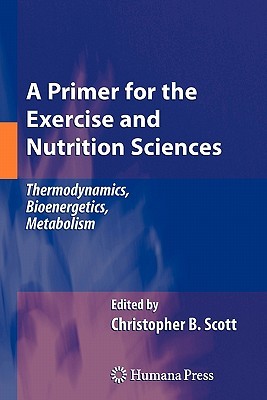
- We will send in 10–14 business days.
- Author: Christopher B Scott
- Publisher: Humana
- Year: 2010
- Pages: 166
- ISBN-10: 1617378933
- ISBN-13: 9781617378935
- Format: 15.6 x 23.4 x 1 cm, softcover
- Language: English
- SAVE -10% with code: EXTRA
A Primer for the Exercise and Nutrition Sciences (e-book) (used book) | bookbook.eu
Reviews
Description
Preface 1. Introduction: Thermodynamics, Bioenergetics, Energy Expenditure Part 1. Thermodynamics 2. Within and Without: Systems and Surroundings 2.1. Isolated systems 2.2. Closed systems 2.3. Open systems 2.4. Life is an open system 3. Conservation 4. Matter and Energy 4.1. Matter 4.2. Energy 4.3. Internal energy 4.4. Internal energy exchanges 5. Energy Accountability: Enthalpy (H) 5.1. The chemical reaction system 5.2. Chemical (standard) enthalpy exchanges 5.3. Biochemical (non-standard) enthalpy exchange 6. Energy has bias: Entropy (S) 6.1. 2nd laws of thermodynamics 6.2. Energy distribution 7. The energy exchange gradient: Gibbs energy (G) 7.1. Delta Go 7.2. Energy unification 7.3. Delta Go': Closed systems under standard conditions 7.4. Delta G: Non-standard conditions Part 2. Bioenergetics 8. Life's Currency: ATP 8.1. ATP: structure and content 8.2. ATP: energy exchange 8.3. ATP: turnover efficiency 8.4. ATP utilization (demand) 8.5. ATP re-synthesis 9. Metabolism as an Energy Exchange Device 9.1. Metabolic power: force and flow 9.2. Negative entropy (?) 9.3. Dynamics of a metabolic pathway 9.4. Intracellular transport 9.5. Time 9.6. Exergy synopsis 10. Anaerobic Metabolism 10.1. A brief history of anaerobic biochemistry 10.2. The glycolytic gradient 10.3. Glycolytic heat and entropy 10.4. 'High-energy' phosphate buffering 10.5. Anaerobic speed 11. Aerobic Metabolism 11.1. Mitochondria 11.2. Krebs cycle: gradient 1 11.3. Electron transport chain: gradient 2 11.4. Proton-motive force: gradient 3 11.5. The creatine phosphate shuttle 11.6. ATP tally Part 3. Energy Expenditure 12. Aerobic Energy Expenditure 12.1. Combustion, respiration and heat 12.2. Thornton's law: combustion 12.3. Respiration and energy expenditure 12.4. Heat and gas exchange 12.5. Aerobic energy expenditure as heat and entropy 12.6. CO2 and O2: aerobic and anaerobic energy exchange 13. Anaerobic Energy Expenditure 13.1. The oxygen deficit 13.2. Lactate 14. Energy Expenditure at Rest 14.1. Measuring energy expenditure: calorimetry 14.2. The energy expenditure of rest 14.3. Eating and energy expenditure 14.4. Pregnancy and energy expenditure 15. Energy Expenditure of Activity (Work and Exercise) 15.1. Rate vs capacity vs METs 15.2. Muscle 15.3. Work and energy expenditure relationships 15.4. Glycolytic versus respiratory efficiency 16. Total Energy Expenditure for Exercise and Recovery 16.1. Aerobic exercise energy expenditure 16.2. Anaerobic exercise energy expenditure 16.3. Aerobic recovery energy expenditure 16.4. Dismissing the oxygen debt hypothesis 16.5. Total energy expenditure 16.6. Weight loss: low vs high intensity activity
EXTRA 10 % discount with code: EXTRA
The promotion ends in 17d.21:49:00
The discount code is valid when purchasing from 10 €. Discounts do not stack.
- Author: Christopher B Scott
- Publisher: Humana
- Year: 2010
- Pages: 166
- ISBN-10: 1617378933
- ISBN-13: 9781617378935
- Format: 15.6 x 23.4 x 1 cm, softcover
- Language: English English
Preface 1. Introduction: Thermodynamics, Bioenergetics, Energy Expenditure Part 1. Thermodynamics 2. Within and Without: Systems and Surroundings 2.1. Isolated systems 2.2. Closed systems 2.3. Open systems 2.4. Life is an open system 3. Conservation 4. Matter and Energy 4.1. Matter 4.2. Energy 4.3. Internal energy 4.4. Internal energy exchanges 5. Energy Accountability: Enthalpy (H) 5.1. The chemical reaction system 5.2. Chemical (standard) enthalpy exchanges 5.3. Biochemical (non-standard) enthalpy exchange 6. Energy has bias: Entropy (S) 6.1. 2nd laws of thermodynamics 6.2. Energy distribution 7. The energy exchange gradient: Gibbs energy (G) 7.1. Delta Go 7.2. Energy unification 7.3. Delta Go': Closed systems under standard conditions 7.4. Delta G: Non-standard conditions Part 2. Bioenergetics 8. Life's Currency: ATP 8.1. ATP: structure and content 8.2. ATP: energy exchange 8.3. ATP: turnover efficiency 8.4. ATP utilization (demand) 8.5. ATP re-synthesis 9. Metabolism as an Energy Exchange Device 9.1. Metabolic power: force and flow 9.2. Negative entropy (?) 9.3. Dynamics of a metabolic pathway 9.4. Intracellular transport 9.5. Time 9.6. Exergy synopsis 10. Anaerobic Metabolism 10.1. A brief history of anaerobic biochemistry 10.2. The glycolytic gradient 10.3. Glycolytic heat and entropy 10.4. 'High-energy' phosphate buffering 10.5. Anaerobic speed 11. Aerobic Metabolism 11.1. Mitochondria 11.2. Krebs cycle: gradient 1 11.3. Electron transport chain: gradient 2 11.4. Proton-motive force: gradient 3 11.5. The creatine phosphate shuttle 11.6. ATP tally Part 3. Energy Expenditure 12. Aerobic Energy Expenditure 12.1. Combustion, respiration and heat 12.2. Thornton's law: combustion 12.3. Respiration and energy expenditure 12.4. Heat and gas exchange 12.5. Aerobic energy expenditure as heat and entropy 12.6. CO2 and O2: aerobic and anaerobic energy exchange 13. Anaerobic Energy Expenditure 13.1. The oxygen deficit 13.2. Lactate 14. Energy Expenditure at Rest 14.1. Measuring energy expenditure: calorimetry 14.2. The energy expenditure of rest 14.3. Eating and energy expenditure 14.4. Pregnancy and energy expenditure 15. Energy Expenditure of Activity (Work and Exercise) 15.1. Rate vs capacity vs METs 15.2. Muscle 15.3. Work and energy expenditure relationships 15.4. Glycolytic versus respiratory efficiency 16. Total Energy Expenditure for Exercise and Recovery 16.1. Aerobic exercise energy expenditure 16.2. Anaerobic exercise energy expenditure 16.3. Aerobic recovery energy expenditure 16.4. Dismissing the oxygen debt hypothesis 16.5. Total energy expenditure 16.6. Weight loss: low vs high intensity activity


Reviews